PASINI REPORTS: WRAP UP
PMA 2008 Highlights: Visions With Blinders
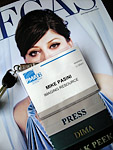 By MIKE PASINI
By MIKE PASINIEditor
The Imaging Resource Digital Photography Newsletter
Despite a show shortened to avoid conflict with the Super Bowl, your Imaging Resource team managed to match its ground-breaking coverage of last year's Photo Marketing Association trade show. Again Imaging Resource sent two video crews and a floor reporter and a photographer to South Hall in the Las Vegas Convention Center to get the story to you.
The Etchells-Deuel and Barnett-Smith video teams have delivered over 40 videos at the time of this writing (and more to come) with the aid of Producer Andrew Alexander. Mike Tomkins, hamstrung by a balky Windows laptop, did manage to get photos of the major booths and will have complete coverage as the week progresses. He also managed, with the help of staffer Siegfried Weidelich to post over 200 press releases related to show news.
And your newsletter editor continued his two-pronged approach, pairing a gallery of dozens of captioned images from each event with a lengthy text report as well. Not counting this report or the soon-to-be-announced Envy awards, over 10,500 words were published in Pasini Reports with almost 300 images.
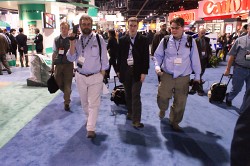
Intrepid Trio. Pasini, Alexander and Deuel at the end of the day. (Photo courtesy of Shawn Barnett, walking backwards.)
While a lot of that was done without sleep, our visions from the week were not just day dreams. "Anything impress you?" we were constantly asked. "What have you seen that you really liked?"
But this year, it took a little time to put the show in perspective. It wasn't so much one product or another that impressed us. It was, despite wearing blinders to focus on each day's report, more a vision of where the business is going these days.
THE CONNECTIVITY CHALLENGE | Back to Contents
One such issue, subterranean as it is, is the connectivity challenge. While digicams and camphones have managed to coexist much like camphones and MP3 players, the one technical aspect where the camphone trumps the digicam remains connectivity. It's still easier to share a camphone image or video than one you take with a digicam.
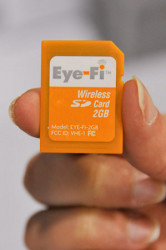
Eye-Fi. A 2-GB SD card that can communicate.
But a couple of developments are chipping away (if not challenging) that advantage. The most exciting one is the Eye-Fi SD card. WiFi transfers have not set the world on fire. Indeed, camphones got their jump on digicams in the connectivity wars by 1) being communications devices to begin with (using the cellphone network to transmit rather small image files) and 2) buttressing that with Bluetooth, which doesn't have the setup overhead of WiFi.
But once set up WiFi is transparent. With 2-GB storage on the Eye-Fi, it need never come out of your camera. And resident there, the Eye-Fi SD card promises to make any SD-capable digicam into a WiFi camera. That means you can share higher-resolution images at the speed of a camphone's smaller resolution images over the cell network. And it may just mean you can do more with video sharing, too, something that even takes a while on a camphone.
The other development of note is Nikon's continuing commitment to WiFi in its Coolpix line. The company has been refining its own sharing service, recently renamed My Picturetown with Fotonation (which during the show was acquired by Tessera Technologies). The Coolpix S51c uploads directly to that service which provides a free 2-GB of storage and free email image sharing. The company is trying to make it as easy to share Coolpix images and video wirelessly as it is to share camphones images.
In that light, it was interesting to see Kodak's new sensor design take form as a 5-Mp KAC-05020 camphone image sensor. The new sensor, which should be appearing in 2009 camphones, adds a clear pixel to the typical RGB Bayer pattern to achieve high ISO without high noise.
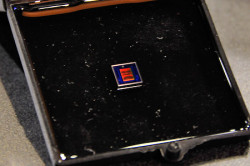
Kodak CMOS Chip. High ISO with no noise and five megapixels -- in a camphone.
"In a standard CMOS pixel," Kodak explained, "signal is measured by detecting electrons that are generated when light interacts with silicon of the sensor. As more light strikes the sensor, more electrons are generated, resulting in a higher signal at each pixel. In the KODAK TRUESENSE CMOS Pixel, however, the underlying "polarity" of the silicon is reversed, so that the absence of electrons is used to detect a signal."
It's something like using color negative film to get three stops of latitude rather than slide film with just one. By reversing the polarity, the noise in the shadows is captured as if they were highlights. A clever idea that is not limited to camphones, we hasten to point out.
But a camphone with that sensor will be able to take pictures unlike any camphone today (yes, even the iPhone). Will it, however, be able to transmit them as easily as today's 2-Mp images?
It is, as we said, the connectivity challenge.
MORE THAN MEGAPIXELS | Back to Contents
You had to be oblivious not to overhear one person confide to another on nearly every aisle of every floor every day of the show that it isn't about megapixels any more.
But what is it about?
Ah, there you had a lot of theories. But what was clear to us was that we've not only moved beyond megapixels, we've moved beyond image processors. We're starting to see cameras -- both digicams and dSLRs -- that can do more than their predecessors ever dreamed. And they manage this with a combination of powerful processors for live functions and powerful post processing of the image as well. Our cameras are turning into photo systems, not simply sensors with an image processor.
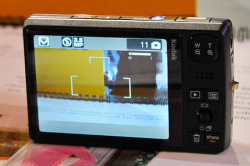
SmartCapture. Not just auto Scene modes.
The simplest illustration of this is Kodak's new SmartCapture mode, available on its new Z1012 IS and compact M1033. SmartCapture picks a Scene mode (although not all Scene modes are supported), sets the white balance and exposure (underexposing a bit) and processes the image (which is why it can underexpose) using a powerful image processor.
But Kodak isn't the only innovator here. Fotonation itself has been driving this trend with its face detection technology, which is now in two of three digicams. And it has extended that to smile recognition and even head counting so your self-timer will wait until you get in the picture before counting down.
Even Casio's EX-F1 illustrates the trend with the high-speed 6-Mp CMOS and a flash that can keep up with its 60 fps speed.
If you used to go shopping for image stabilization and more of a zoom range than 3x, you're now going to be lusting after some magic tricks.
That goes for dSLR buyers, too.
We're seeing Live View crop up even on the Canon Rebel. And features like Nikon's D-Lighting are now applied at the time of capture, not as an edit, to overcome the tendency toward dark images that a digital linear capture implies. Canon's version is called Auto Lighting Optimizer. That's a tremendous entry level feature, addressing the number one complaint new dSLR owners have. Dark pictures.
THE RANGEFINDER | Back to Contents
If all that makes your head swim and you'd just like to wrap your hands around a simple camera, take heart. The rangefinder is not dead, nor are its pleasures diminished.
Leica announced it was going to offer upgrades to the M8 in perpetuity (or as close as we mortals come to it) rather than develop an M9 or M10. Considering the personal (even mystical) relationship Leica owners have with their cameras, that can only be comforting news (although reviewers might be a little miffed not to get an M8 like every other M8).
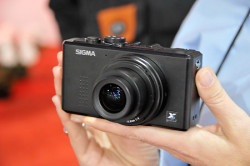
DP1 and 28mm Lens. Look for it in March.
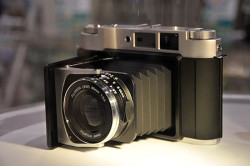
Fujifilm Prototype. It's not about the megapixels.
Is it that modular it can be easily updated, we asked Leica's Christian Erhardt. He nodded. It's a rangefinder, after all. You can't expect your Nikon D200 to turn into a D300 with a trip to the factory, but Leica can replace the back panel on the M8 to give you a better LCD or swap out the shutter. You'll have to pay about as much as it would cost to buy a D300, but you do get a two-year extension to your warranty. And your old friend back, too.
There was something retro even about the long-delayed DP1 from Sigma with its Foveon sensor. And that something was the audacity of offering a camera with a 28mm fixed focal length lens, Franny. No zoom, Zooey. Are they crazy, we wondered.
Probably, but there is a certain discipline to shooting wide angle. And to be candid for a moment, we have taken several hundred product shots with a wide angle converter lens married to our old Nikon 990 in macro mode. We just like the personality of that point of view. Works exceptionally well in crowded rooms and wide open spaces (landscapes), too.
As if that isn't enough to make traditionalists smile, Fujifilm showed a prototype medium format film camera using 120/220 film with an 80mm f3.5 lens and electronically controlled shutter. With a shutter speed as fast as 1/500 second, it adds a folding bellows, a hot shoe and a thumbwheel film advance to make the illusion complete.
The death of the rangefinder has been greatly exaggerated.
Photo printing has gradually moved over the last year from the small 4x6 printer that is nearly foolproof to the all-in-one box that everyone has to have.
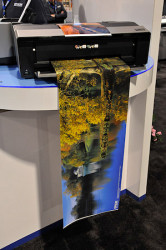
Epson. Drooling with color.
But both Epson and HP are providing the big thrill: a 13x19 printer at a reasonable price (not a lot more than one of those all-in-ones). Epson's R1900 has a roll feeder for endless panoramas while HP's B8850 (based on the pro B9180) offers three-gray black and white printing. If either of those capabilities draws a line in the sand for you, don't sweat the other details.
We were delighted to see this trend because 13x19 printing is look-Mom-no-cavities photo printing. You owe it to yourself to get a printer that can make these wonders so you can stand back and admire what that little camera of yours can really do. You just can't appreciate that in a 4x6 print.
We were a little surprised not to see Adobe (which had a meeting room hidden away somewhere) or Apple (Aperture seems to be all but forgotten) at the show. Maybe they're packing for photokina already.
But a couple of companies intrigued us with what we can only call liberated versions of their technology.
Nik Software introduces its Viveza Photoshop plug-in that uses the company's unique U Point technology to edit images without masks. This is Nikon Capture NX for the rest of us. If you have trouble getting your images to look the way you'd like, give U Point a try.
It's simple. You just click the place in the image that needs work. That puts a control point there. Then you use any of the multiple sliders associated with the control point to modify the image until it looks the way you want. If you can use a slider, you can edit images.

iNova. Absolutely no special effects were applied to this image.
Of course, if you have Photoshop, you don't really need Viveza to get what you want. But it beats learning how to use adjustment layers and make contrast masks. Life, after all, is short.
We were also glad to see Peter iNova come out with his collection of over 600 Photoshop effects in a new eBook that is not tied to a particular camera model. If you're camera takes six to 12 megapixel images, these effects will work on them. And the eBook illustrates just what they'll do.
Just one of the intriguing aspects of the new release is that you can order it as either a $64 CD or a $69 thumbdrive (and even slightly less if you take advantage of the Dave's Deal provided our newsletter subscribers). The thumbdrive is worth the extra five bucks. You don't have to copy the effects to your hard drive (as you do with the CD), you just load them straight from the thumbdrive.
We all have shoeboxes of prints and envelopes of negatives. Even binders of negatives, come to think of it. Fortunately not on the scale of our digital collections, but if you're not careful you can inherit just such a pile.
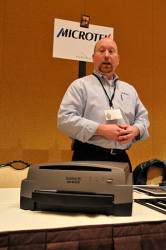
M1. Parker demonstrated the autofocusing flatbed with film resolution.
We're constantly asked how to digitize them, or worse, which flatbed scanner to buy. As if one could actually live long enough to digitize a lifetime of film images. You can't.
We usually recommend a local pro scanning service without naming names, but at the show we saw a couple of interesting possibilities.
The first was Kodak's Rapid Print Scanner. It isn't really available yet, but seed units have been out in the field and may be coming to a lab near you in kiosk form before the Easter bunny.
You can throw prints and negatives at it and it will batch scan them for you. Just bring your shoebox to the store, stack your prints (and which way) in the scanner and get a disc with the scans. And it's quick, doing about 30 prints a minute at 300 dpi.
The unit we observed had a little trouble feeding the images (and was gone the next time we walked through the booth, indicating a hardware failure). But we chatted with a friendly dealer who had been using one of the seed units. It has a few bugs to work out, he told us, but he was excited about the possibilities.
It doesn't make high quality scans, though, so you will get to see them in your lifetime. For those images that really deserve the royal treatment, though, Microtek brought its Artixscan M1 to DigitalFocus. We've been working on a review (in diary format) of it since the end of last year and are excited about what it can do for two reasons.
The first is Microtek's dual bed design, which eliminates that glass plate between the sensor optics and the emulsion. The second is that this is the first flatbed film scanner with autofocus. That promises to deliver some exceptional scans. Microtek's Parker Plaisted gave us reason to hope with his portfolio of large prints made from M1 scans. And that's just what you want for your heirloom images.
We saw a lot more (we're still excited about Op/Tech's Adapt-Its, but you'll have to read our show reports to find out why) than we can report in one wrap up story. But our perspective this year went beyond individual products and neat features.
And adds another 2,500 words to our coverage, BTW <g>.